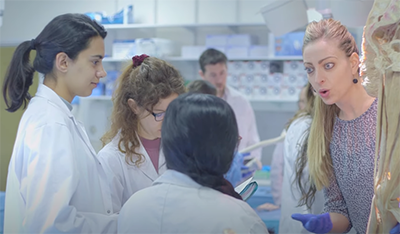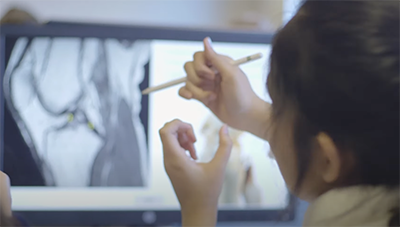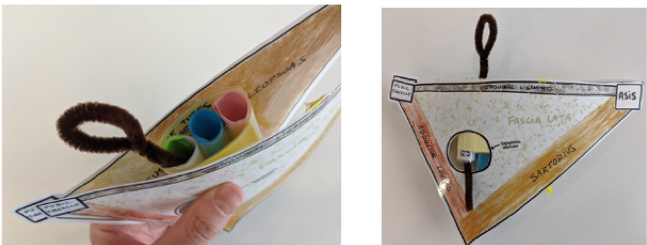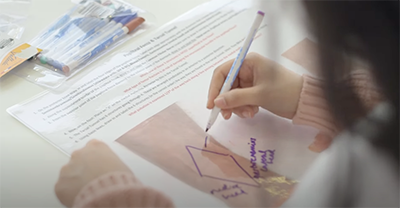ADAPTABLE CLINICAL ANATOMY: HOW COVID CHANGED THE WAY WE TEACH

Covid-19 has affected every university and every degree, but none more so than a course as hands-on as Medicine. Here, Professor Richard Tunstall and Dr Erin Fillmore explain how our clinical anatomy teaching has been forever changed as a result of the pandemic.
The new processes and resources created have forever changed our conceptualisation of how clinical anatomy can be experienced, taught and learnt.
Over the past year, the field of medical education and the individuals within it have felt the colossal impact of the coronavirus pandemic. Students and educators alike have feverishly had to find new ways in which to navigate both unknown waters and new constraints in learning. While individual experiences and responses throughout the pandemic have no doubt varied, at some level individual perceptions of ‘normal’, ‘expected’, ‘given’ and ‘the possible’ will have been challenged.
 The key challenge we faced in clinical anatomy was how best to adapt our learning product to preserve the hands-on, exploratory, practical, clinically applied and interwoven nature of our curricular package, while simultaneously ensuring the accommodation of fluctuating restrictions and rapidly evolving demands. From the outset, we committed to ensure that no learner would be disadvantaged, no matter what the resource requirement or workload implication to ourselves.
The key challenge we faced in clinical anatomy was how best to adapt our learning product to preserve the hands-on, exploratory, practical, clinically applied and interwoven nature of our curricular package, while simultaneously ensuring the accommodation of fluctuating restrictions and rapidly evolving demands. From the outset, we committed to ensure that no learner would be disadvantaged, no matter what the resource requirement or workload implication to ourselves.
The continued training of the future NHS workforce to the highest standard was our primary concern, and this could not be compromised. Unsurprisingly, the past year fiercely tested this commitment and created the most demanding, albeit the most rewarding, chapter of our careers.
What did we do?
As a team we oversee, develop and deliver the clinical human anatomy curriculum within the four-year MB ChB programme. At the heart of everything we do is an intentional driving of the learning process, via a seamless and cohesive learning journey that optimises (and places centre-stage) learner experience. We are not a team to accept what is assumed or opinionised to be best practice; evidence, reflection and student and peer review are key to our development process. This is a deliberate, active and continuous process in which we work collaboratively with our learners to enhance day-to-day learning.
But then the pandemic hit, and rather than view Covid-19-based restrictions as a temporary impediment, we seized the opportunity to analyse the purpose, place and efficiency of every part of our teaching and learning product. Our refocused aim was to develop an inspirational curricular product that enhanced the learning process, accessibility, inclusivity and learner experience no matter what the delivery format, while simultaneously being efficient, robust and flexible enough to cope with online platforms, asynchronous delivery, educator/learner absences or session cancellations.

Since the summer of 2020, we have conducted the largest ever enhancement of our learning processes and products. This has not only achieved our aims but has generated a sustainable learning product and collection of best practice techniques. Examples of the core changes include:
- developing a new templated multi-stage learning process, based upon the multiple theories model of learning, self-regulation and the formative assessment process, that runs effectively with either synchronous or asynchronous online or in-person learning opportunities.
- developing new categories of accessible learning opportunities for each stage of the learning process that enable learners to sequentially construct, apply and test their knowledge. For example:
- Watch-It: concise video-based packages (5-20 min) for asynchronous use, designed to introduce concepts, inspire and lead into the learning process.
- See-It, Feel-It: applied hands-on workshops with human tissue and living subjects.
- Draw-It, Do-It: drawing, model construction tasks and online seminars that demand engagement, target threshold concepts and further the learning process.
- A suite of medical imaging training packages, supported by multimedia resources (generated in-house), that enable small group (n=3) discussion and continued application of knowledge online.
- providing learning resources in a clear, visually appealing pre-packaged format
- enhancing the diversity and inclusivity of visual media.
- multi-platform hosting of video-based media to enhance accessibility.
- establishing production standards and quality assurance processes for audio-visual products.
- training learners about our learning processes and learning culture in clinical anatomy: including the theories and processes we use and why. For example, how effective learning feels and how best to engage in the anatomy curriculum.

An example of how students have learnt about the femoral triangle and femoral canal
What impact have these changes had?
This year we have seen that our students are more enthused, better prepared, more engaged and self-motivated, and more able to identify, discuss and explore their unknowns. We have often heard students in clinical anatomy sessions using the phrase, ‘trust the process’. Student feedback shows that they genuinely appreciate the creative, applied and inventive learning opportunities we provide which generate a safe environment for exploration and the time to make and correct their mistakes. They also appreciate the fact that we intentionally reiterate challenging concepts using different techniques to ensure accessibility and success – always providing them with personalised challenges that prompt their exploration. To quote one student, “Given all the ways that we learn anatomy, it would be harder not to learn it, than it is to actually learn it!”. We believe that our clear and consistent templating and explanations of our expectations and learning process enables learners to better comprehend their tasks and goals and feel guided and supported despite learning primarily at distance.

Looking forward: Will we ‘go back’ to the way things were?
Simply put, our changes are here to stay – because they enhance learning and the learner experience! While Covid-19 forced us (in a rather accelerated, and at times exhausting way) to adapt and reinvent how we structure and deliver our teaching products, it has led to something better than we ever expected. The new processes and resources created have forever changed our conceptualisation of how clinical anatomy can be experienced, taught and learnt. Driven by evidence and supported by a wealth of positive student feedback and performance enhancement, we could not be prouder of what we have achieved in this challenging pandemic environment. Our practices and perceptions of how clinical anatomy can be taught are forever transformed.

